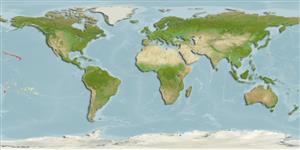>
Mulliformes (Goatfishes) >
Mullidae (Goatfishes)
Etymology: Parupeneus: Latin, parum, parvum = small + Peneus, the name of a river; chrysonemus: Named for its golden yellow barbels..
More on authors: Jordan & Evermann.
Environment: milieu / climate zone / depth range / distribution range
นิเวศวิทยา
เกี่ยวกับทะเล,น้ำเค็ม สัตว์น้ำหน้าดิน; ระดับความลึก 20 - 183 m (Ref. 54393), usually 60 - ? m. Tropical
Eastern Central Pacific: Hawaii and Johnston islands.
ขนาด / น้ำหนัก / Age
Maturity: Lm ? range ? - ? cm
Max length : 19.6 cm SL เพศผู้/กระเทย; (Ref. 54393)
เงี่ยงครีบหลัง (รวม): 8; ก้านครีบอ่อนที่หาง (รวม): 9; ก้านครีบอ่อนที่ก้น: 7. Diagnosis: Pectoral rays nearly always 16 (4 of 36 specimens with 15 on one side and 17 on the other). Gill rakers 7-8 + 25-28 (total 32-35). Body depth 3.3-4.05 in SL; head length (HL) 2.7-3.05 in SL; eye relatively large, the orbit diameter 4.4 - 5.3 in HL (118-196 mm SL); snout length 1.65-2.1 in HL (snout progressively longer with growth); barbel long 1.1-1.3 in HL; dorsal spine longest in HL; last dorsal rays about equal in length; pectoral-fin length 1.35-1.5 in HL; pelvic fins 1.2-1.4 in HL. White, scale edges narrowly dark, with a red or brown band from front of snout along back adjacent to base of dorsal fins, the scales within band with dark brown edges, and many with a dark brown spot; a red or dark brown stripe from front of snout through eye and broadening as it follows the lateral line; stripe partially interrupted below rear base of second dorsal fin, then ending in a broad slightly oblique bar on caudal peduncle; a vertically elongate dark red or dark brown spot within stripe behind eye in line with posterior margin of preopercle; barbels varying from bright red to yellow or mixed red and yellow; membranes of first dorsal fin red; second dorsal fin red basally, the outer half with narrow irregular pale yellow and pale blue bands separated by dark reddish lines; anal fin with similar bands on all of fin; caudal fin mainly yellow, usually with small white spots basally; pelvic fins largely red. Specimens from the deep water are entirely red without upper band and lateral stripe; a dark red spot behind eye; fins colored as in shallower-water fish except caudal fin more red (Ref. 54393).
Found over sand (Ref. 58302). Generally found at depths deeper than 60 meters (Ref. 54393).
Life cycle and mating behavior
วัยเจริญพันธุ์ | การสืบพันธุ์ | การวางไข่ | เซลสืบพันธ์ของเพศเมีย(ไข่) | ความดกของไข่ | ตัวอ่อน
Randall, J.E., 2004. Revision of the goatfish genus Parupeneus (Perciformes: Mullidae), with descriptions of two new species. Indo-Pac. Fish. (36):64 p. (Ref. 54393)
IUCN Red List Status (Ref. 130435)
Threat to humans
Harmless
Human uses
ข้อมูลเพิ่มเติม
ชื่อสามัญชื่อพ้องกลไกการเผาผลาญพลังงานผู้ล่าการศึกษาเกี่ยวกับผลกระทบของสารประกอบทางเคมีที่เป็นอันตรายต่อสิ่งมีชีวิต ประชากร และสิ่งแวดล้อมการสืบพันธุ์วัยเจริญพันธุ์การวางไข่การรวมกลุ่มวางไข่ความดกของไข่เซลสืบพันธ์ของเพศเมีย(ไข่)Egg development
อ้างอิงการเพาะเลี้ยงสัตว์น้ำประวัติการเพาะเลี้ยงสัตว์น้ำสายพันธุ์พันธุศาสตร์ElectrophoresesอัตราพันธุกรรมโรคการแปรรูปNutrientsMass conversion
ผู้ร่วมมือรูปภาพหลายรูปStamps, Coins Misc.เสียงปลามีพิษ เช่น ปลาปักเป้าความเร็วรูปแบบการว่ายน้ำพื้นที่เหงือกOtolithsสมองวิสัยทัศน์
เครื่องมือ
Special reports
Download XML
แหล่งที่มาจากอินเตอร์เน็ต
Estimates based on models
Preferred temperature (Ref.
123201): 7.5 - 20.2, mean 10.1 °C (based on 7 cells).
Phylogenetic diversity index (Ref.
82804): PD
50 = 0.5000 [Uniqueness, from 0.5 = low to 2.0 = high].
Bayesian length-weight: a=0.01202 (0.00556 - 0.02601), b=3.10 (2.93 - 3.27), in cm total length, based on LWR estimates for this Genus-body shape (Ref.
93245).
ระดับชั้นอาหาร (Ref.
69278): 3.4 ±0.4 se; based on size and trophs of closest relatives
ความสามารถในการกลับคืนสู่ปกติ (Ref.
120179): ความสูง, เวลาต่ำสุดที่จะทำให้ประชากรเพิ่มขึ้นเป็น 2 เท่าใช้เวลาน้อยกว่า 15 เดือน (Preliminary K or Fecundity.).
Fishing Vulnerability (Ref.
59153): Low vulnerability (14 of 100).
Nutrients (Ref.
124155): Calcium = 131 [47, 384] mg/100g; Iron = 0.651 [0.305, 1.675] mg/100g; Protein = 17 [14, 20] %; Omega3 = 0.249 [0.125, 0.526] g/100g; Selenium = 91.3 [36.1, 252.8] μg/100g; VitaminA = 69.4 [12.9, 332.3] μg/100g; Zinc = 0.606 [0.337, 1.242] mg/100g (wet weight);
